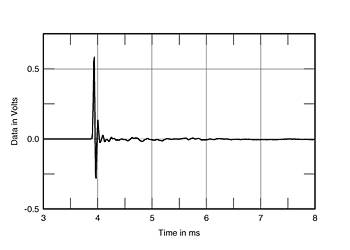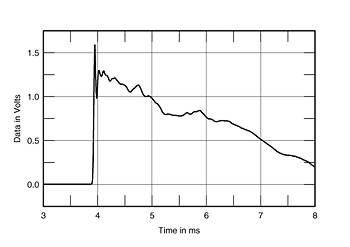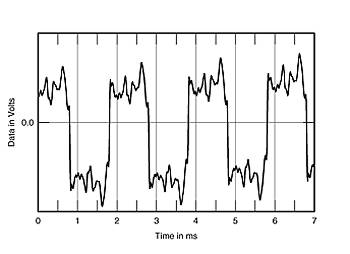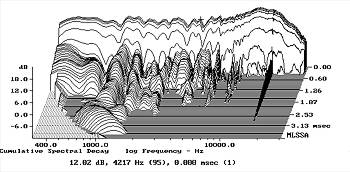| Columns Retired Columns & Blogs |
Dunlavy Audio Labs SC-IV/A loudspeaker Measurements part 3
In the time domain, the Dunlavy's impulse response on the tweeter axis (fig.7) is excellent and typical of a first-order design that physically recesses the shallower drive-units. There are a couple of early reflections noticeable, however, which I assume are from the relatively firm felt used in the tweeter's acoustic environment. These give rise to the small ripples seen in the on-axis frequency response, which are subjectively benign. The step response (fig.8) indicates excellent time coherence, the acoustic outputs from all five drive-units arriving at the microphone at the same time. The slight overshoot correlates with the excess of HF energy apparent in the frequency response on this axis at this mike distance, and again the early reflections can be seen.

Fig.7 Dunlavy SC-IV/A, impulse response on tweeter axis at 50" (5ms time window, 30kHz bandwidth).

Fig.8 Dunlavy SC-IV/A, step response on tweeter axis at 50" (5ms time window, 30kHz bandwidth).
Because of its time coherence, the Dunlavy is one the handful of loudspeakers that can reproduce an acoustic squarewave. Fig.9 shows a 500Hz squarewave captured on the tweeter axis at 100". Note the excellent risetime and the good square shape, broken up by some ripples which may be due to the reflections noted in the impulse and step response but might also be due to room reflections at the this farther mike distance.

Fig.9 Dunlavy SC-IV/A, waveform of 500Hz squarewave at 50" on HF axis (7ms time window, 30kHz bandwidth).
Finally, the SC-IV/A's cumulative spectral-decay or waterfall plot on the tweeter axis at 50" shows an excellent drop in energy once the exciting pulse has passed, this expected from the time-coherent impulse response. But what appear to be slight resonant ridges in the mid-treble might really be the effect of the early reflections.

Fig.10 Dunlavy SC-IV/A, cumulative spectral-decay plot at 50" (0.15ms risetime).
Summing up these measurements, the SC-IV/A is another well-engineered speaker design from John Dunlavy. I am not surprised RD liked it as much as he did.—John Atkinson
- Log in or register to post comments




































